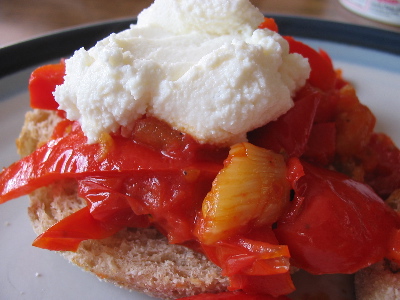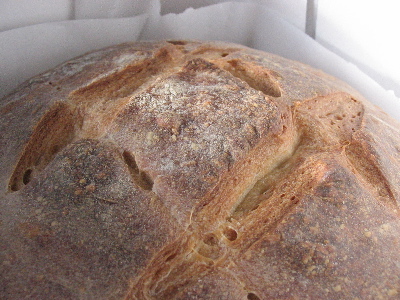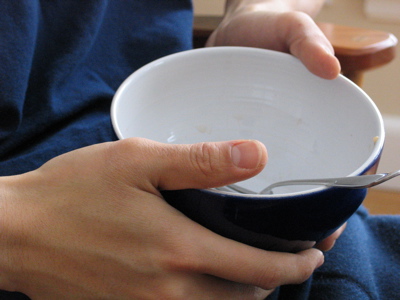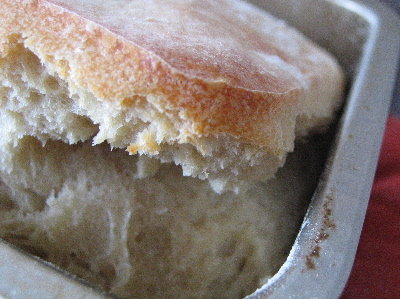Sometimes I think about moving somewhere other than my current neighbourhood, but then I think about my butcher, and sanity returns. I can move when he retires. The Upper West side has Fairway, and the Lower East has Chinatown, but in order to walk to a butcher of anything like this quality, I’d probably have to pay two thousand a month for a SoHo shoebox so I could get to Florence Meat Market (which I’ve never actually tried, but am taking to be good on faith).
Mario is about the size of a side of pork, and the texture of guanciale. He keeps a soapbox behind his display case, which he has to mount in order to hand you your meat. He’s also got a big nose, and wears a black fisherman’s hat, and I’m tempted to ask if he was ever a plumber. His sons, on the other hand, are all pretty much the size and shape of a side of beef, and they all have shaved heads and neat goatees. The only way to tell them apart, as far as I know, is by size. There’s large, larger, and largest. The walls behind the counter are covered with pictures of grandspawn, some clearly mailed over from Italy. Every time I go in – every single time – there will be three people in the shop. Mario, one of his sons, and a different random guy who looks like an old Italian sailor. It’s that kind of place.
Though it’s called Mario and Sons, Mario clearly never taught his sons anything, and is trying to make up for lost time. I’ll tell Mario what I want, and he’ll jabber at his son in grouchy Italian. The son will look clueless for a moment, go to one of the three freezers, and pull out the Wrong Thing. Mario will slap the worthless bugger, who will wince and look hurt, and dive into the freezer himself, and pull out the Right Thing (the difference between the Wrong Thing and the Right Thing is usually imperceptible to me). He’ll give the son a chance to redeem himself by preparing my cut properly, but then the son will somehow mess up while unwrapping the meat, and Mario will loose another irate volley, cursing the woman who brought such weakness into the family line, the fact that he can no longer sire a more suitable heir, and the very presence of a Chinaman in his shop. I assume.
Some butchers caress their meat, some work with an intensity bordering on rage, so much so you almost expect your steak to be black and blue by the time they hand it over. Mario is an enlightened stoic by nature, and simply expects the meat to obey him. His movements are almost callous, made in the full confidence that a particular interaction of steel and meat will have a particular effect. But he obviously understands cooking – all truly good butchers have to - so perhaps there is poetry underneath all that crust, like sweet white fat beneath prosciutto rind.
The last time I went in, I made the mistake of asking too many questions. All I said was, “Mario, do you have lamb neck?”
“I have everyt’ing.”
“Lamb neck?”
“Everyt’ing – you want lamb, I have. You want veal, I have. You want pork” and at this point he reaches over the counter and grabs my arm “I have. I have chops, I have shoulder,” he’s jumped off the soapbox and is pulling me towards the walk-in, which, coincidentally, is also the general direction in which the three butcher blocks, knives uncounted, and bandsaw are. “I have butt, I have leg, I have loin.” He opens the walk-in, and shoves my head in. “You want lamb? This is lamb.”
He’s grabbed an entire side of creature, hanging by the freezer door. There are four others right behind it. “This is veal. This is pork. And there – beef.” Two whole steers.
I prefer to visit with Stakhanovite, because he charges based on his mood, and she charms him. I’d post a picture, but I’m afraid he’ll never let me in again if I bring a camera into his shop.
Mario and Sons Meat Market
Metropolitan Avenue at Graham Avenue, Williamsburg
Take the L to Graham Avenue. The station is at the junction of Graham and Metropolitan. Mario is 2 blocks down Metropolitan, in the direction away from the White Castle.




